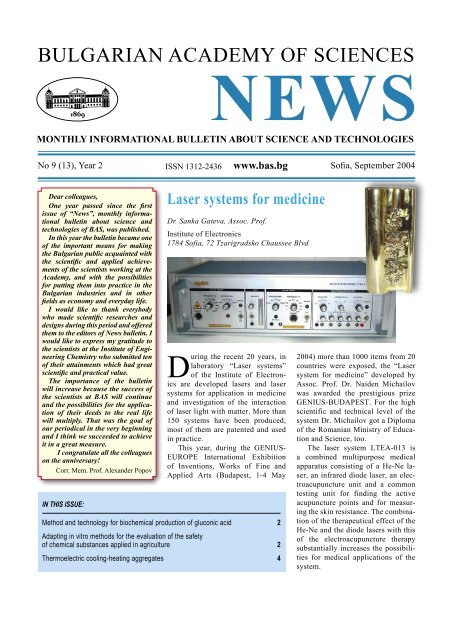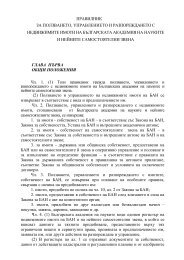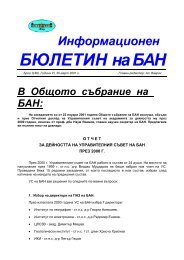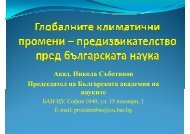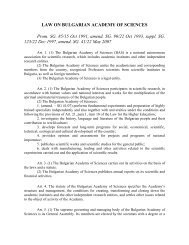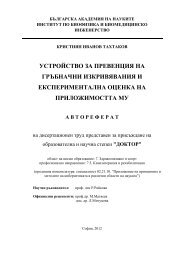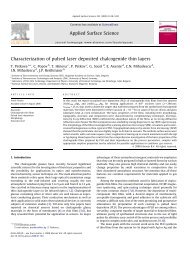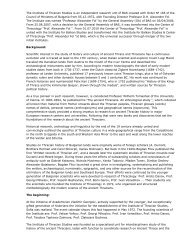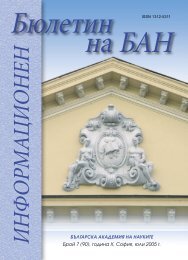BULGARIAN ACADEMY OF SCIENCES
BULGARIAN ACADEMY OF SCIENCES
BULGARIAN ACADEMY OF SCIENCES
You also want an ePaper? Increase the reach of your titles
YUMPU automatically turns print PDFs into web optimized ePapers that Google loves.
2NEWS Science and TechnologySeptember 2004The LTEA-013 system has elegant designand it is easy-to-operate. It can be applied for:• detection and skin-resistance measurements of the active points and continuousmonitoring of the treatment effect.• He-Ne laser therapy (wave length 632.8 nm) in continuous and pulsed modes ofoperation.• IR diode laser therapy (wave length 904 nm) in continuous and pulsed modes ofoperation.• Five-channel electroacupuncture therapy with controlled output voltagein 3 different modes of operation.Modifications of thesystem are the acupuncturemodel LTEA-011 and theelectroacupuncture modelEMNA. The EMNA modelcan work at 3 differentfrequencies with modulation,which is one of themost modern methods forincreasing the efficiency ofthe treatment.Method and technology forbiochemical productionof gluconic acidProf. Venko Beshkov, DScInstitute of Chemical Engineering1113 Sofia, Acad. Georgi Bonchev Str., Bl. 103Application area: Medicine, housing construction,processing of metalsD-gluconic acid is applied in some areas of humanactivity. It is used mainly as its calcium salt inmedicine as a heart stimulator in an infusion form.Besides that it has technical applications as a meansfor rust removing from metal surfaces and for removal ofother corrosion products. On the other hand, gluconic acidis used in construction as an additive to concrete mixtures,thus enhancing their strength and mechanical resistance.Another new application of gluconic acid is the perspectivebiochemical production of L-ascorbic acid (e.g.,vitamin C).There are two main methods for production of gluconicacid: electro-chemical and biochemical ones. The firstmethod leads to non-controlled by-products formation, aswell as consecutive formation of degradation ones. Thereforethe main product is considerably contaminated, thusimpeding the downstream processing, particularly in thecase of medical purposes.There was a technology developed in the Institute ofChemical Engineering at the Bulgarian Academy of Sciencesfor the biochemical production of D-gluconic acid,based on own scientific research. Controlled productionof consequent oxidation products, like 2-keto- and 5-ketogluconicacids is available too. The latter two acids areintermediates in a recently proposed biochemical synthesisof vitamin C.The technology for biochemical production of gluconicacid is an “one-step” one and product is obtainedwith a sufficiently high yield (over 90%) and with a sufficientlypurity and high enough concentrations. All thesefacts facilitate the further isolation and purification of theproduct for medical purposes. If the product is for technicalapplication the downstream processing is considerablysimplified.The technology enables the selective process performance,with a controlled production of the keto-acids.Theirproduction could be either promoted or inhibited accordingto the manufacturing purposes.Adapting in vitro methods for the evaluation of the safetyof chemical substances applied in agricultureAss. Prof. Margarita Georgieva, PhDInstitute of Experimental Pathology and Parasitology1113 Sofia, Acad. Georgi Bonchev Str., Bl. 25Ass. Prof. Georgi T. Georgiev, PhDInstitute of Physiology of Plants1113 Sofia, Acad. Georgi Bonchev Str., Bl. 21Developed intensively in the last two decades are invitro methods for establishing the mechanisms of actionof different chemical substances, their impact atthe cellular and tissular level and the determination of theircytotoxicity, mutagenicity and carcinogenicity. The aim isthese techniques to complete or to substitute entirely the testson animals carried out until then as a model for the evaluation
September 2004 Scientific ProjectsNEWS3of the safety of pharmacological agents, nutritional productsand preparations applied in agriculture. The Program for theEvaluation of the Toxicity of Chemical Substances, launchedin 1989 and realized by MEIC (The Multicenter Evaluation ofIn Vitro Cytotoxicity) unites the investigations of 96 internationallaboratories whose task in the first stage, already completed,was to study the opportunities of different in vitro testsfor the evaluation of the safety of chemical substances. Thesecond stage involves the creation of a complex methodologyuniting the respective in vitro techniques that should substitutethe experiments in vivo because of their high cost and duration.Making tests in so many laboratories led to certain differencesin the final results because of the different criteria inthe interpretation of the data obtained. This fact imposed thenecessity of introducing unified standards for the countries thatwere members of the Common Market. Today, the followingstandards are in use: The Tripartite Guidans; The InternationalOrganization for Standardization (ISO) 10993, known as theBiological Evaluation of Medical Devices, that are still beingdeveloped, and The EDA Blue Book Memorandum, G95-1,valid only for the USA.In the Memorandum (MEMO/02/61 of 19.03.2002) at theConference on Issues of Farming, The Council of Ministersat the European Union (EU) emphasized the harmonization ofthe legislation of each one of the countries as an obligatorycondition for the countries candidates for the EU with respectto the safety of nutritional products. On the occasion of theserequirements, as well as after the adoption of Directive 76/768/EEC for banning the use of tests animals in the toxicologicalinvestigation of ingredients or combinations of ingredients ofcosmetic products (Directive 2000/41/EEC), enforced from30.06.2002, researchers from the Institute of ExperimentalPathology and Parasitology and the Institute of Physiologyof Plants at the Bulgarian Academy of Sciences put forwarda Project for the Development of a Complex Methodology forthe Evaluation of the Safety of Chemical Substances Appliedin Agriculture. In 2002 the project was approved and financedby the Ministry of Education and Science.With this purpose in mind, different modifications of theLACT<strong>OF</strong>OL leaf suspension fertilizers were studied, thesehaving been created by a team from the Institute of Physiologyof Plants at the Bulgarian Academy of Sciences. The suspensionsare a new generation of complex leaf fertilizers in whichall metal ions are linked to lactic acid which, after their intakeby the plants, enters directly the metabolism and there are noremains of organic solvents in the products. The LACT<strong>OF</strong>OLproducts are registered by the Ministry of Agriculture and havebeen regularly exported from the country in the course of severalyears already. So far, eight modifications have been licensed,taking into account typology, the specificity of the climate, soilsand phase deficits with respect to different nutritional elements.Two new modifications are being developed at the moment.In connection with the determination of toxicity of otherchemical substances used in agricultural practice, some widelyemployed herbicides and growth regulators were also studied.To that end, the first approved test for cytotoxicity was applied– -3T3 Neutral Red Uptake In Vitro Test, validated inProtocol No 78 of INVITTOX, and Appendix V, B41 “In Vitro3T3 NRU Phototoxicity Test” of Directive 67/548/EEC/2000/33EEC.The results obtained allow us to make the following moreimportant conclusions:In the comparative testing of two cell lines – CHO-K1(ovarial cells from a Chinese hamster) and BALB/c 3T3,branch 31 (mice embryonal fibroblasts), a considerable differencewas established with respect to their sensitivity to alltested chemical substances. The CHO-K1 cell line showedhigher sensitivity in all tests. Its inclusion in the in vitrotesting of the toxicity of different substances, apart from theBALB/c 3T3, officially recognized as a model, expands theset of test-systems and, showing a greater sensitivity, allowsus to use it successfully in testing the safety of biologicallyactive substances.All modifications of the LACT<strong>OF</strong>OL leaf suspensionfertilizers have relatively low levels of cytotoxicity. Takinginto account the fact that the helatomaker used is in this casea natural product obtained in the dairy industry, as well as thedata for toxicity (published for the first time as a result of thisstudy), we think that this group of fertilizers can be successfullyused in agriculture with a view of obtaining ecologicallyclean products.As a result of the additional investigations made concerningthe toxicity of herbicides and synthetic growth regulators widelyapplied in practice, the toxicity of the corresponding preparationsin vitro was determined for the first time, thus proving ina categorical way the existing correlation between the data fortoxicity obtained from test animals, expressed as LD 50(LethalisDoses 50 in vivo) and the data from the in vitro tests.In the present second stage, conforming with the requirementsof OECD (Organization for Economic Cooperation andDevelopment) No 476/1997, the In Vitro Mammalian CellGene Mutation Test – CHO/HGPRT Mutatuion InductionAssay was approved. It was proved that the investigated modificationsof the LACT<strong>OF</strong>OL fertilizers do not induce mutationsin the HGPRT locus of cells from the ovary of a Chinesehamster and are safe for people’s health.Possible fields of application:• Investigations of naturally obtained and newly synthesizedchemical substances – pharmaceutical, cosmeticand nutritional products, preparations appliedin agriculture, preservatives, etc. with respect to toxiceffects on people and animals.• Investigations of naturally obtained and newly synthesizedchemical substances – pharmaceutical, cosmeticand nutritional products, preparations appliedin agriculture, preservatives, etc. with respect to theirability to cause mutations in the genome of cells ofmammals in vitro.
4NEWS Scientific Projects September 2004Thermoelectriccooling-heating aggregatesAss. Prof. Minko Neshev, PhDAss. Prof. Lydia Bedikian, PhDRes. Ass. Christo BahchedjievRes. Ass. Tetiana CholakovaCentral Laboratory of Applied Physics4000 Plovdiv, 59 Sankt Petersburg BlvdApplication area: Medicine, pharmacy, stomatology,telecommunications, electronics, jewellery, transport,consumer products, etc.Figure 1. Refrigerator (mini-bar)Thermoelectric cooling-heatingaggregates are deviceswith thermoelectric modulesas active elements and the basicconcept behind is the Peltier effect.Whenever electrical directcurrent flows through a module, itabsorbs heat energy from one sideof the module, called “cool”, transportsand releases it at the oppositeside, called “hot”. By switchingoff thermoelectric current polarity,the Peltier module cools orheats closed systems, or enclosures.Generally, each aggregateconsists of one or more thermoelectricmodules, spacers, heat exchangersand thermalinsulation.Heat is absorbedand dissipatedby heat sink/fan combinations.In comparisonwith conventionalcooling systems, thermoelectricaggregateshave a number of advantages:environmentally saved– without toxic refrigerant gases,compact sizes, high reliabilityand long service life, less energyconsumption, possibility of DC,or converted AC, or both supplies,etc. Aggregates with cooling powers30, 45 and 60 W are designedand manufactured.Thermoelectric coolingaggregates have ahigh efficiency mountedin portable bag coolers,containers and cameras,consumer refrigeratorsfor cooling food anddrinks, and with thepossibilities of bothpower supplies are particularlyappropriate forthe transport. Figure 1represents our portableFigure 2. Isothermal containerrefrigerator with capacity of 30 or50 l, power supply 12 or 24 V DCand 220 V, 50 Hz AC, and averagepower consumption 50 W. Furthermorethe isothermal container forstorage and transport of blood andother temperature-sensitive medicalgoods, designed to meet the requirementsof field conditions, as well ascold plate for stomatology and jewelleryare designed and manufactured.The isothermal container (Figure 2)is a thermostabilizer with automaticallymaintained temperature in thevolume between 1 and 8ºC, whenambient temperature is from – 20 to+ 40 ºC, power supply 11÷33 V DC and220 V, 50 Hz AC, and after a powercut, the holdover time is 10 hours atan ambient temperature of 32 ºC.ISSN 1312-2436www.bas.bgАcademic Publishing House “Мarin Drinov”, 1113 Sofia, Acad. Georgi Bonchev Str., Bl. 6,Head Editor: Corr. Mem. Prof. Alexander Popov, tel.:(+359 2) 987 46 53, e-mail: novosti@eagle.cu.bas.bg;Editor-in-chief: Sonia Slavova, tel.:(+359 2) 870 40 92, e-mail: soniats@abv.bgNo part of this publication may be reproduced or published by any meanswithout the prior permission of the publisher.


